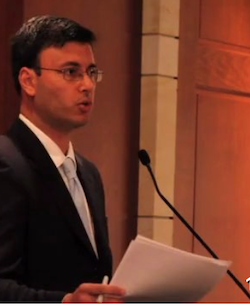 In August 2022 the Office of the National Coordinator for Health Information Technology (ONC) launched the 2022 Public Health Data Systems Task Force as a subcommittee of the Health Information Technology Advisory Committee (HITAC). The task force will meet through the beginning of November to present recommendations continuing and building upon the work of the 2021 task force. Members of the task force include individuals from various levels of government, relevant public health associations, and industry partners. Specifically, the task force is focused on the certification criteria for EHR products certified under the ONC Health IT Certification Program that cover transmission of data from EHRs to public health in these domains...
In August 2022 the Office of the National Coordinator for Health Information Technology (ONC) launched the 2022 Public Health Data Systems Task Force as a subcommittee of the Health Information Technology Advisory Committee (HITAC). The task force will meet through the beginning of November to present recommendations continuing and building upon the work of the 2021 task force. Members of the task force include individuals from various levels of government, relevant public health associations, and industry partners. Specifically, the task force is focused on the certification criteria for EHR products certified under the ONC Health IT Certification Program that cover transmission of data from EHRs to public health in these domains...
syndromic surveillance
See the following -
Accelerating Identification and Tracking of Pandemic Disease Outbreaks
By Payam Etminani, and Joel Mewton | March 15, 2015
 A national biosurveillance program requires the collaboration of multiple federal, state and local agencies to provide a comprehensive view of a health-related event. Bitscopic's Praedico™ biosurveillance platform breaks down the data barriers among organizations with an extensible architecture that can incorporate any kind of data. The platform also delivers high performance by incorporating the latest technologies such as big data, NoSQL databases, and machine learning. Read More »
A national biosurveillance program requires the collaboration of multiple federal, state and local agencies to provide a comprehensive view of a health-related event. Bitscopic's Praedico™ biosurveillance platform breaks down the data barriers among organizations with an extensible architecture that can incorporate any kind of data. The platform also delivers high performance by incorporating the latest technologies such as big data, NoSQL databases, and machine learning. Read More »
- Login to post comments
Ebola in the United States: Short on Accountable 'Open' Information, Effective Systems Planning and Decision Making
By Marc Wine | October 29, 2014
 Events in the present Ebola crisis prompt unease that the United States deployment of Web based, standardized population health and biosurveillance information services is fragmented, incomplete and insufficient, prompting me to write this blog. The United States has made significant progress in public health and medical preparedness since the 9/11 terrorist attacks; yet, poorly interconnected information systems add to our vulnerability to planning and response to viruses like Ebola or enviro virus EV-D68 that threaten the health of large populations. Today, a gap exists between information technology specialists and public health programmatic or scientific personnel.
Events in the present Ebola crisis prompt unease that the United States deployment of Web based, standardized population health and biosurveillance information services is fragmented, incomplete and insufficient, prompting me to write this blog. The United States has made significant progress in public health and medical preparedness since the 9/11 terrorist attacks; yet, poorly interconnected information systems add to our vulnerability to planning and response to viruses like Ebola or enviro virus EV-D68 that threaten the health of large populations. Today, a gap exists between information technology specialists and public health programmatic or scientific personnel.
- Login to post comments
Halamka on MU3 Regs: The Good, The Bad, and the Ugly
By John D. Halamka, MD | March 26, 2015
 On Friday March 20, CMS released the Electronic Health Record Incentive Program-Stage 3 and ONC released the 2015 Edition Health Information Technology (Health IT) Certification Criteria, 2015 Edition Base Electronic Health Record (EHR) Definition, and ONC Health IT Certification Program Modifications. Perhaps the most important statement in the entire 700+ pages is the following from the CMS rule: "Stage 3 of meaningful use is expected to be the final stage and would incorporate portions of the prior stages into its requirements."
On Friday March 20, CMS released the Electronic Health Record Incentive Program-Stage 3 and ONC released the 2015 Edition Health Information Technology (Health IT) Certification Criteria, 2015 Edition Base Electronic Health Record (EHR) Definition, and ONC Health IT Certification Program Modifications. Perhaps the most important statement in the entire 700+ pages is the following from the CMS rule: "Stage 3 of meaningful use is expected to be the final stage and would incorporate portions of the prior stages into its requirements."
- Login to post comments
Halamka Summarizes the CMS Meaningful Use Final Rule
By John D. Halamka, MD | October 20, 2015
 I’ve been asked to summarize the 752 page CMS Meaningful Use Final Rule...Between the Notice of Proposed Rulemaking and the publication of the CMS Final Rule, the Medicare Access and CHIP Reauthorization Act of 2015 (MACRA) passed to include sunsetting the Meaningful Use payment adjustment for professionals at the end of 2018. Also, MACRA requires the establishment of a Merit-Based Incentive Payment System (MIPS) which would incorporate Meaningful Use. The comment period will be used in an attempt to align the Meaningful Use program and the MIPS program...Stage 3 is more controversial and I will focus on that.
I’ve been asked to summarize the 752 page CMS Meaningful Use Final Rule...Between the Notice of Proposed Rulemaking and the publication of the CMS Final Rule, the Medicare Access and CHIP Reauthorization Act of 2015 (MACRA) passed to include sunsetting the Meaningful Use payment adjustment for professionals at the end of 2018. Also, MACRA requires the establishment of a Merit-Based Incentive Payment System (MIPS) which would incorporate Meaningful Use. The comment period will be used in an attempt to align the Meaningful Use program and the MIPS program...Stage 3 is more controversial and I will focus on that.
- Login to post comments
Health Organizations Implore Congress to Fund Public Health Surveillance Systems
By Noam H. Arzt, Ph.D. | March 29, 2019
 HLN Consulting joined more than eighty organizations, institutions, and companies in imploring Congress to fund public health surveillance systems. The appropriations request letters – one to the House and one to the Senate – seek one billion in funding over ten years (and $100 million in FY 2020) for the Centers for Disease Control and Prevention (CDC). This funding would allow CDC, state, local, tribal, and territorial health departments to move from sluggish, manual, paper-based data collection to seamless, automated, interoperable IT systems and to recruit and retain skilled data scientists to use them.
HLN Consulting joined more than eighty organizations, institutions, and companies in imploring Congress to fund public health surveillance systems. The appropriations request letters – one to the House and one to the Senate – seek one billion in funding over ten years (and $100 million in FY 2020) for the Centers for Disease Control and Prevention (CDC). This funding would allow CDC, state, local, tribal, and territorial health departments to move from sluggish, manual, paper-based data collection to seamless, automated, interoperable IT systems and to recruit and retain skilled data scientists to use them.
- Login to post comments
Inside The Struggle For Electronic Health Record Interoperability
Greg Otto | FedScoop | August 20, 2014
Over the past few months, stories have popped up chronicling doctors’, clinicians’ or other health care providers’ headaches moving to and/or accessing EHRs. The chorus of complaints has led the Senate Appropriations Committee to submit language in a draft bill that calls for a report from the Department of Health and Human Services’ Office of the National Coordinator for Health Information Technology (ONC) on what “the challenges and barriers” are to EHR interoperability.” Read More »
- Login to post comments
ONC HITAC Public Health Data Systems Task Force Releases Recommendations
By Noam H. Arzt, Ph.D. | November 18, 2022
 On November 10, 2022 the Office of the National Coordinator for Health Information Technology’s (ONC) Health Information Technology Advisory Committee (HITAC) accepted and approved the recommendations of its ad hoc Public Health Data Systems Task Force. As discussed in an earlier post, the Task Force has been meeting since August 2022 and was charged with examining how improvements might be made in ONC certification rules for criteria related to public health data submission. In addition, and perhaps for the first time, the task force was also charged with developing recommendations related to the public health side of the equation: how public health data systems and/or standards might improve to ensure a smoother flow of information with clinical care. Read More »
On November 10, 2022 the Office of the National Coordinator for Health Information Technology’s (ONC) Health Information Technology Advisory Committee (HITAC) accepted and approved the recommendations of its ad hoc Public Health Data Systems Task Force. As discussed in an earlier post, the Task Force has been meeting since August 2022 and was charged with examining how improvements might be made in ONC certification rules for criteria related to public health data submission. In addition, and perhaps for the first time, the task force was also charged with developing recommendations related to the public health side of the equation: how public health data systems and/or standards might improve to ensure a smoother flow of information with clinical care. Read More »
- Login to post comments
ONC Launches Public Health Data Systems Task Force
By Noam H. Arzt, Ph.D. | September 18, 2022
Overdue Outbreak Detection System Leaves Patchwork Defense
Madison Alder | Bloomberg | July 30, 2019
 The U.S. should have had a nationwide network to monitor for the next viral outbreak or biological threat a decade ago. It still doesn't. Instead, public health leaders make do with a patchwork system while waiting for the Department of Health and Human Services races to get its integrated network in service by a new 2023 congressional deadline. Until that nationwide monitoring system is in place, the U.S. runs the risk that a biological threat like a disease outbreak will take hold before it's noticed. "The risk is that we don't have the level of surveillance that we need. The risk is that there are things basically flying under the radar," said Helen Boucher, an infectious diseases clinician at Tufts Medical Center in Boston and director of the university's Center for Integrated Management of Antimicrobial Resistance.
The U.S. should have had a nationwide network to monitor for the next viral outbreak or biological threat a decade ago. It still doesn't. Instead, public health leaders make do with a patchwork system while waiting for the Department of Health and Human Services races to get its integrated network in service by a new 2023 congressional deadline. Until that nationwide monitoring system is in place, the U.S. runs the risk that a biological threat like a disease outbreak will take hold before it's noticed. "The risk is that we don't have the level of surveillance that we need. The risk is that there are things basically flying under the radar," said Helen Boucher, an infectious diseases clinician at Tufts Medical Center in Boston and director of the university's Center for Integrated Management of Antimicrobial Resistance.
- Login to post comments
The Experience of Interoperability Thus Far
By John D. Halamka, MD | January 21, 2015
 As I travel across the country and listen to CIOs struggling with mandates from Meaningful Use to ICD-10 to the HIPAA Omnibus rule to the Affordable Care Act, I'm always looking for ways to reduce the burden on IT leaders. All have expressed frustration with the health information exchange (HIE) policies and technologies for care coordination. quality measurement, and patient engagement. As a country, what can we do to reduce this anxiety? Read More »
As I travel across the country and listen to CIOs struggling with mandates from Meaningful Use to ICD-10 to the HIPAA Omnibus rule to the Affordable Care Act, I'm always looking for ways to reduce the burden on IT leaders. All have expressed frustration with the health information exchange (HIE) policies and technologies for care coordination. quality measurement, and patient engagement. As a country, what can we do to reduce this anxiety? Read More »
- Login to post comments
Using Open Technology To Build a Biodefense Against the Coronavirus
By Shastri Purushotma | February 3, 2020
 As the number of US cases of the coronavirus rises, how will healthcare professionals be able to tell the difference between which panicked patients with similar symptoms has what? Even if the patient hasn't traveled to Wuhan or China recently, what if they sat at a Starbucks with someone who did? With the incubation time-lag before symptoms appear, who would even know? The challenge of monitoring 330 million people for infectious disease outbreaks is daunting. Take the flu as an example. During the last flu season which, as already discussed, was not as complex as this year's season, approximately 35.5 million Americans had flu symptoms, 16.5 million received medical care, 490,600 were hospitalized and 34,200 died.
As the number of US cases of the coronavirus rises, how will healthcare professionals be able to tell the difference between which panicked patients with similar symptoms has what? Even if the patient hasn't traveled to Wuhan or China recently, what if they sat at a Starbucks with someone who did? With the incubation time-lag before symptoms appear, who would even know? The challenge of monitoring 330 million people for infectious disease outbreaks is daunting. Take the flu as an example. During the last flu season which, as already discussed, was not as complex as this year's season, approximately 35.5 million Americans had flu symptoms, 16.5 million received medical care, 490,600 were hospitalized and 34,200 died.
- Login to post comments
VA Selects Bitscopic's Praedico for Public Health Surveillance
Press Release |
Bitscopic |
March 20, 2015
 Bitscopic Inc., a leading provider of health analytics tools, announced today that the U.S. Department of Veterans Affairs (VA) has selected its Praedico platform to detect and monitor infectious disease outbreaks across the country. In addition, the VA is going to pilot Bitscopic's advanced analytics software for the early detection and management of hospital acquired infections (HAI) and other clinical informatics applications. Bitscopic's Praedico scans data from electronic health records (EHRs), laboratories, pharmacies, and other sources in seconds. It has been used to analyze infectious disease data including influenza, dengue, Hepatitis C (HCV), etc. Praedico is a modular, highly configurable, and customizable platform. It can detect and monitor large-scale events such as antibiotic resistance trends and potential major disease outbreaks. In addition, it monitors more localized events and tools, such as patient monitoring devices, and surgical site infections. Read More »
Bitscopic Inc., a leading provider of health analytics tools, announced today that the U.S. Department of Veterans Affairs (VA) has selected its Praedico platform to detect and monitor infectious disease outbreaks across the country. In addition, the VA is going to pilot Bitscopic's advanced analytics software for the early detection and management of hospital acquired infections (HAI) and other clinical informatics applications. Bitscopic's Praedico scans data from electronic health records (EHRs), laboratories, pharmacies, and other sources in seconds. It has been used to analyze infectious disease data including influenza, dengue, Hepatitis C (HCV), etc. Praedico is a modular, highly configurable, and customizable platform. It can detect and monitor large-scale events such as antibiotic resistance trends and potential major disease outbreaks. In addition, it monitors more localized events and tools, such as patient monitoring devices, and surgical site infections. Read More »
- Login to post comments